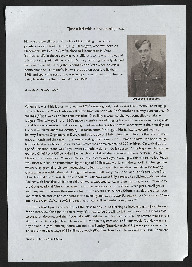Eric Coling memoir
Title
Eric Coling memoir
"Just a lad with a hole in his jersey"
Description
Time in the RAF including selection as an observer, enrolment at Lord's Cricket Ground, navigational dead reckoning and meteorology training in Eastbourne and Paignton. Time spent on navigational sorties in Grahamstown, South Africa in Ansons and bombing training in Oxfords. Meeting Winifred Scott after she had been dancing at the MECCA ballroom whilst he was at an Operational Training Unit at RAF Upper Heyford. Training as a bomb aimer, crewing up with navigator Bunny Ridsdale, wireless operator Alex Noble, Canadian pilot Ron Code and rear gunner Ray Moad, flying Vickers Wellingtons, including a leaflet drop over Nantes. Move to 1660 Conversion Unit at RAF Swinderby and joining mid-upper gunner Johnny Boyton and flight engineer Spike Langford and flying Manchesters followed by the four-engined Avro Lancaster. Move to No.5 Group, 50 Squadron at RAF Skellingthorpe, serving under Wing Commander Robert McFarlane. Operations to Hamburg, where window was used for the first time, Mannheim, Nuremberg, Milan, operation Hydra at Peenemünde and the ‘Battle of Berlin’. Best man at sister, Muriel's wedding, who worked for the Ministry of Information at the Government Code and Cypher school at Bletchley Park. Further training in formation and low-level flying. Aircraft 'L-Love' hit by flak and landing at RAF Kirmington. Mine laying outside Gdynia harbour, Poland. Attack by JU88's and ditching in the sea. loss of Bunny Ridsdale, rescue by Danish fishermen, detention by German naval officer and transfer to Dulag Luft, the Luftwaffe Interrogation Centre, and transfer to Stalag 4b, as prisoner of war. Meeting American forces, transfer to Brussels in a DC-3 and repatriation to Great Britain in a sterling. Marriage to Winifred Scott, in St. Peter's Church, Harrogate, with Johnny Boyton as best man. Work with London, Midlands & Scottish railway and later move to Tanzania to work for East African Railways.
Creator
Date
2014-10
Spatial Coverage
Language
Format
Fourteen page printed document with photographs
Conforms To
Publisher
Rights
This content is available under a CC BY-NC 4.0 International license (Creative Commons Attribution-NonCommercial 4.0). It has been published ‘as is’ and may contain inaccuracies or culturally inappropriate references that do not necessarily reflect the official policy or position of the University of Lincoln or the International Bomber Command Centre. For more information, visit https://creativecommons.org/licenses/by-nc/4.0/ and https://ibccdigitalarchive.lincoln.ac.uk/omeka/legal.
Identifier
BBarffAColingEFv1
Collection
Citation
Andy Barff, “Eric Coling memoir,” IBCC Digital Archive, accessed August 24, 2024, https://ibccdigitalarchive.lincoln.ac.uk/omeka/collections/document/40648.
Item Relations
This item has no relations.

